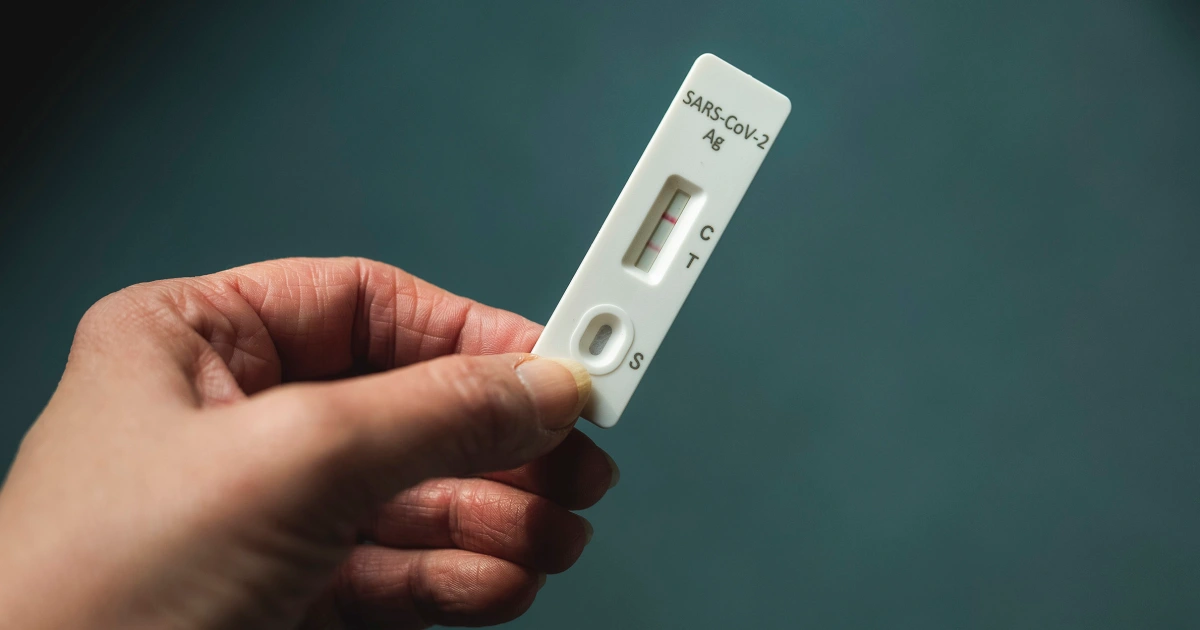Copyright TODAY

As we get into another winter holiday season, COVID is still part of our lives. And although it's hard to predict exactly what this year's cold, flu and coronavirus season will look like, experts want to make sure you've brushed up on the basics of COVID testing. This is the time of year when we've typically started to see COVID cases increasing, and it's a good bet that we'll see a similar pattern this winter. "I would guess that over the winter months, we'll see an increased amount of COVID infections, similar to other viral infections, partly because of human behavior," Dr. Geeta Sood, an assistant professor of medicine and hospital epidemiologist at Johns Hopkins Bayview Medical Center, tells TODAY.com. We know that COVID tends to spread more easily when people are in close proximity, so holiday gatherings with family and friends could make infections more likely to jump from person to person. While it's reasonable to assume we will see a COVID spike this winter, "we still don't know what the seasonality is going to be," Dr. Richard Martinello, professor of internal medicine and pediatric infectious diseases at the Yale School of Medicine, tells TODAY.com. With fewer folks getting vaccinated against COVID these days, it’s possible that we may see even more cases this winter season than we did in past years, Sood explains. “This year may give us a nice challenge because there’s not as much enthusiasm for the vaccine as I would like,” Martinello agrees. Regardless of the way this winter season shakes out, knowing that COVID is still very much with us means it's still important to keep our basic tools — especially at-home COVID testing — in mind. How Accurate Is At-Home COVID Testing? "I'm very enthusiastic about at-home testing," Martinello says. While at-home tests are not as sensitive as a test that relies on polymerase chain reaction (PCR) technology, "the fact that you can do them at home is a really wonderful place to start," he says. A PCR test detects the actual genetic material of the virus and involves a step that amplifies the presence of any material that might be there, which means it can detect a smaller amount of virus, Dr. Daniel D. Rhoads, chair of the College of American Pathologists microbiology committee, tells TODAY.com. Instead, at-home tests typically look for a specific antigen, a type of protein that the genetic material of the virus encodes, Rhoads explains. Think of the viral signal as someone whispering to you from across the room, Rhoads explains. "It's hard to hear it, but if they amplify it with a microphone — the amplification step in PCR testing — it makes it easier to hear," he says. Meanwhile, rapid antigen tests "only pick up (the signal) if somebody's shouting from across the room," Rhoads explains. Generally, that means an at-home COVID test isn't as sensitive as a PCR test. So, if you get a negative result with a rapid antigen test, you may need to re-test a day later to be sure. But if you get a positive result, you can trust it — even if it's faint. While it may be tempting to think of COVID just another virus like a cold or the flu, it is different. People aren't dying or getting hospitalized at the same rates we saw early in the pandemic, Sood says, but people are still at risk for long COVID. Additionally, about two thirds of Americans have one or more risk factors for severe disease due to COVID or the flu, Martinello notes. For people in those categories, knowing which illness they have is crucial to getting proper antiviral treatment, the experts agree. When to Take an At-Home COVID Test You should take a rapid antigen test for COVID when you have noticeable symptoms that are consistent with a coronavirus infection. That might include flu- or cold-like symptoms such as: Sore throat (including so-called "razor blade throat") Fever or chills Cough Congestion or runny nose Shortness of breath Headache or muscle aches Nausea, vomiting or diarrhea New loss of taste or smell The at-home tests are more likely to be accurate when you have noticeable symptoms than when you're asymptomatic, the experts say. Keep in mind that, if you take a rapid antigen test too early in your infection, it may give you a false negative result. If you've been exposed to COVID but don't have symptoms, you should follow the FDA's advice to wait five days after the exposure before using an at-home test, Rhoads adds. When to Take Another Test If you have COVID-like symptoms but get a negative result on a rapid antigen test, that doesn't mean you're in the clear. Testing can be "kind of complicated because testing is not cheap, and a single test is not extremely sensitive," Sood says. "So if you really want to know if you have COVID, you may have to do multiple tests." In certain circumstances, you may need to take another test (or even two) before you can be confident in a negative result, Rhoads explains, noting that the Food and Drug Administration still recommends serial testing. And you should assume you could have COVID while waiting to take the subsequent tests and take appropriate precautions, the experts say. If you have symptoms and get a negative result on your first test, take another test 48 hours afterward. If that one is also negative, take a third test 48 hours after the second test. If you don't have symptoms but are testing because you've been exposed, take your first test five days after the exposure, and if it's negative, take another test 48 hours later. If that's negative, test again after another 48 hours. If you get a positive test at any point during that routine, you most likely have COVID-19 and don't need to do any more testing to confirm that. Should You Test Before a Holiday Gathering? If you don't have any symptoms of COVID but want to test just in case before a gathering of friends or family, you can do that, the experts say. But keep the limitations of at-home tests in mind — namely, that it's possible to test negative and still be infectious and risk spreading it to people at the gathering. Rhoads says it's "reasonable" to take a test before an event if you think you've been exposed and you're worried about shedding the virus asymptomatically. "But remember that it's not foolproof, and it's just a snapshot in time," he notes. It's possible to test negative before an event and positive the next day, for example. Knowing that, the best time to take a test is as close to the time of the event as possible, Rhoads advises. “The at-home tests really don’t perform well in those circumstances,” Martinello says, adding that nearly all of us have some degree of immunity to COVID now. “So if somebody really wanted to do it, I wouldn’t necessarily advise against it,” he says. But, for most of us, "I don’t think it’s worth it at this point,” Martinello says. Still, it makes sense to think about who else is going to be at the gathering — and what other measures you can take to keep everyone a little safer, including getting recommended vaccines and taking precautions in the days leading up to your event. Additionally, "cleaner air is always a good idea," Good says, so consider opening windows if the weather allows it or using HEPA air purifiers. And, of course, you should stay home if you feel sick, Rhoads says, regardless of whether or not you test positive for COVID or any other illness. That's especially true if you know vulnerable people will be present, such as elderly grandparents, pregnant people, young children or folks who are immunocompromised. Where to Get Free COVID Tests In previous years, the federal government has mailed out free COVID tests to individual households, and insurance companies have helped cover some of the costs of at-home tests. But the situation is quite different this year. There has been no indication that there will be another round of free COVID tests from the government this year. (The website that Americans used in past years to order the tests now redirects to a government site sharing unproven theories about the origins of the pandemic.) And insurance coverage for COVID tests will largely depend on your individual plan, AHIP, the trade group for private insurance companies, tells TODAY.com. While many plans still continue to provide reimbursement for a certain amount of at-home tests (usually up to six to eight tests per month), policies differ from plan to plan. If you're unsure, you should check in with your employer or health plan for clarity, AHIP says. You can also check whether your plan covers COVID tests with a pharmacist at the drug store or the drugstore website, such as Walgreens or CVS. And keep in mind that at-home COVID tests (as well as masks and hand sanitizer) are generally considered eligible for coverage under a Health Savings Account and other similar accounts, according to the Internal Revenue Service. Even five years in, there is still "a lot of confusion" around COVID-19 testing, Sood says, "and it's already an evolving area to begin with." Taking precautions — getting vaccinated, keeping areas well ventilated, taking a test when appropriate — helps keep everyone safer.



